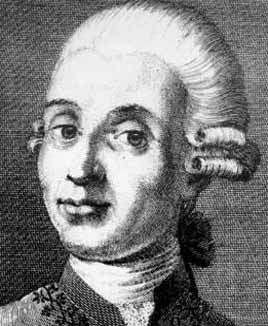


 تاريخ الرياضيات
تاريخ الرياضيات
 الرياضيات في الحضارات المختلفة
الرياضيات في الحضارات المختلفة 
 الرياضيات المتقطعة
الرياضيات المتقطعة
 الجبر
الجبر
 الهندسة
الهندسة 
 المعادلات التفاضلية و التكاملية
المعادلات التفاضلية و التكاملية 
 التحليل
التحليل
 علماء الرياضيات
علماء الرياضيات |
Read More
Date: 30-6-2016
Date: 30-6-2016
Date: 31-3-2016
|
Born: 1731 in Ala, Trento, Italy
Died: 9 October 1807 in Ferrara, Italy

Gianfrancesco Malfatti studied under Vincenzo Riccati, F M Zanotti, and G Manfredi at the College of San Francesco Saverio in Bologna. Then, in 1754, Malfatti went to Ferrara where he taught mathematics and physics in a school that he started up there.
The University of Ferrara was erected by Alberto V who reigned over Ferrara from 1388 to 93. The University was obtained by Pope Boniface IX as a concession in 1391 and this is taken as its founding date. Copernicus studied there in 1503 but the buildings which house the University today date from the end of the 16th-century. The University of Ferrara was re-established in its 16th-century buildings in 1771 and Malfatti was appointed to the chair of mathematics there in that year.
Struik, describing the papers in [2], writes that Malfatti:-
... was a quiet, scholarly man who spent most of his life as a librarian and professor in Ferrara. He was one of the founders of the "Societa Italiana delle Scienze" (1782) and was active in academic reform, especially in the Napoleonic period.
Malfatti wrote an important work on equations of the fifth degree. In 1802 he gave the first solution to the problem of describing in a triangle three circles that are mutually tangent, each of which touches two sides of the triangle, the so-called Malfatti problem. His solution was published in a paper of 1803 on un problema stereotomica.
Jacob Bernoulli had solved this for an isosceles triangle while, after Malfatti, the problem was also solved by Steiner and Clebsch, the latter solving it using elliptic functions.
Malfatti's interests extended beyond this geometrical problem, however:-
His papers dealt with many subjects from probability to mechanics and he participated in the debate around Ruffini's attempt to prove the impossibility of solving (in the meaning of that period) equations of higher degree than four.
There are several papers in [2] which describe Malfatti's work. These include: Problems and methods of mathematical analysis in the work of Gianfrancesco Malfatti, Contributions of Gianfrancesco Malfatti to combinatorial analysis and to the theory of finite difference equations, The work of Malfatti in the realm of mechanics, The geometrical research of Gianfrancesco Malfatti, Gianfrancesco Malfatti and the theory of algebraic equations, and Gianfrancesco Malfatti and the support problem.
We should note some interesting results which he obtained. In 1781 he showed that the lemniscate had the property that [1]:-
... a mass point moving on it under gravity goes along any arc of the curve in the same time as it traverses the subtending arc.
Books:
Articles:



|
|
|
|
التوتر والسرطان.. علماء يحذرون من "صلة خطيرة"
|
|
|
|
|
|
|
مرآة السيارة: مدى دقة عكسها للصورة الصحيحة
|
|
|
|
|
|
|
نحو شراكة وطنية متكاملة.. الأمين العام للعتبة الحسينية يبحث مع وكيل وزارة الخارجية آفاق التعاون المؤسسي
|
|
|